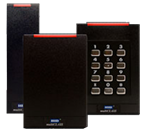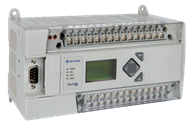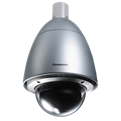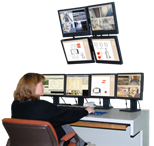Physical Security SolutionsEnterpriseSMS® is the perfect solution for physical security applications. Agnostic about components, ESMS provides advanced capabilities for all types of access control, intrusion detection, video management, communications, and command center operations. Powerful operator GUIs leverage the software’s capabilities to create a situational awareness and command capability not seen in any other product. These GUIs are described below. Physical security demands that the software be capable of connecting to myriad types of devices including traditional devices like credential readers, door sensors, locks, signage and exit buttons. Less traditional field devices might include license plate readers, truck scales, chemical and radiation detectors and many other kinds of special sensors. So, much of the system function is dependent on tracking the state of gates, doors and special portals. The system also tracks the identity credentials (badges, PINs, fingerprints, etc.) presented by accessors to gain approval for entry. EnterpriseSMS® utilizes non-proprietary components to provide the interface to these types of devices. As a result, the same products used for other applications may participate in access control and vice versa. In fact, physical security state monitoring is an application of ESMS’s broadly capable state monitoring and control capabilities that are the core of its SCADA and industrial operations applications. Below, different physical security applications are discussed. These discussions introduce presentations and white papers that will help you understand why Enterprise is so unique and capable at providing such solutions. ESMS’s applications in support of physical security are highly advanced and can provide support for any sized enterprise spread across the world.
Access ControlESMS supports all kinds of traditional approaches to access control like interfacing to other’s access control head ends or integrating access panels made by third parties. Both of these approaches are fine for facilities of standard access points. They are inadequate for complex access points. ESMS can do them all. Typically we will. Complex access points typically involve multiple types of credentials that vary with accessors even in the same transaction. The typically involve non-traditional sensors such as license plate readers, sensors like radiological and chemical, load cells for vehicle weight, and reference to databases like bills of lading, trip tickets, etc. Always video is integrated into complex access points. Many of these types of access points have specific roles for ESMS implemented this type of access in pure software connected to necessary field devices. Cost competitive even for the simplest doors, this powerful approach is enormously flexible and scalable. Click on the papers and presentations below for more information.
Video ManagementEnterpriseSMS® is the right choice for the integration of video in your system. The ESMS solution is completely agnostic about the manufacturers of your video edge components like NVSs and field components like Cameras and positioning systems. Multiple supplier Beyond enormous flexibility is the choices of video components, ESMS also provides the Enterprise Command Station or ECS. See below for this powerful and flexible user interface tool! The white papers below provide additional technical information plus an inventory of supported capabilities.
ESMS CommunicationsWithin ESMS these capabilities include voice communications but also include multi-media So, solutions involving non-VoIP devices of any type are possible as well as VoIP enabled devices. Many if not most telephone systems today are VoIP telephone systems. If a site does not have a VoIP system, ESMS can provide one. This enables all of the functions of a powerful open source telephony application Asterisk including merging all audio field devices into a single subsystem. The link below will provide more information about Asterisk.
Intrusion DetectionIntrusion detection is the process of monitoring a potentially diverse set of sensors for their individual state and applying rules to the collected device states to determine if an intrusion has occurred. There are many simple examples in access control. Consider a door controlled by a badge reader. Usually, if the door is opened without a valid badge read, the opening is considered an intrusion or “forced door”. If the door is opened as part of a valid access transaction, then the occasion of the opening means that an authorized access was detected. If not, then there was an access grant without actual entry. Finally, if the opening occurs but the door does not close within a prescribed period of time a “propped” door will be reported. All of these different scenarios represent rules based on the state changes of a door position sensor and the virtual state of the access point. These rules are defined in software based on menu selections. Parameters are entered into a form that turns on and off selected rules. Any device may be use to fulfill the information requirements of the rule just as multiple devices may also be part of the calculation of a state, real or virtual. Intrusion detection is implemented as rules applied to device and virtual states. Of course, for most situations these rules are well defined and automatically applied to the various devices as they are defined. One value of ESMS is that any device may perform in any role and be subject to any rule. Since such a general capability has been used to support physical security, the link below will lead to a general treatment of state monitoring.
Credential Management and Visitors
|
||



 local and/or gate operations and command center personnel.
local and/or gate operations and command center personnel.  systems are no problem.
systems are no problem.  and SMS messages.
and SMS messages. 

 From a physical security perspective, ESMS and the ECS provides an unusual set of capabilities. Since within the ECS all types of information are treated equally, if an operator is working with a video window they can perform any function that can be performed in a graphics, geospatial maps, communications, and alarm monitoring window and vice versa.
From a physical security perspective, ESMS and the ECS provides an unusual set of capabilities. Since within the ECS all types of information are treated equally, if an operator is working with a video window they can perform any function that can be performed in a graphics, geospatial maps, communications, and alarm monitoring window and vice versa.